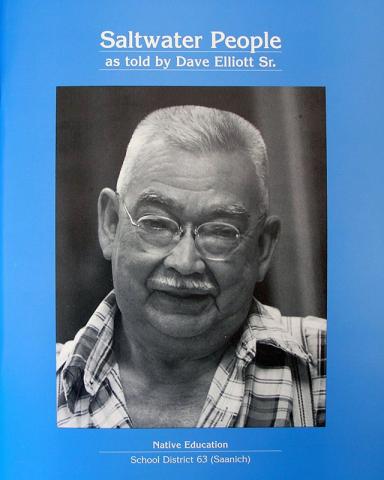 In an era when the English reading and writing Saanich Person was not entirely common, not to mention the preservation on knowledge through a literacy, seeking to record a version of Saanich History from a Saanich person’s perspective was met with no small amount of scrutiny from natives and non-natives alike. On the Saanich side of the argument, one could argue that establishing Saanich History as a ‘solid,’ outside of the ‘oral tradition,’ was broadly considered discourteous by its presumption that Saanich history could be adequately represented as Saanich and accessed by Saanich people. From a colonial perspective, there was already a well-established ‘tradition’ of flagrantly dismissing the ‘Indian expert's’ point of view. In such an era my grandfather, David Elliot Sr., began to think out and record his memoir style representation of Saanich History: The Saltwater People. This was an attempt to lay the foundational record of the settler’s impact on traditional Saanich knowledge and on the SENĆOŦEṈ, the Saanich Language. The Saltwater People not only contained his memories, a unique phonic system for SENĆOŦEṈ and place names within traditional Saanich Territory, it also offered his interpretation of our collective identity: We are the Saltwater People, a people who relied on our centuries-old knowledge for food, travel and the continuing development of our physical, mental and spiritual selves. In fact we once spent as much time on the water as we did on the land.
In an era when the English reading and writing Saanich Person was not entirely common, not to mention the preservation on knowledge through a literacy, seeking to record a version of Saanich History from a Saanich person’s perspective was met with no small amount of scrutiny from natives and non-natives alike. On the Saanich side of the argument, one could argue that establishing Saanich History as a ‘solid,’ outside of the ‘oral tradition,’ was broadly considered discourteous by its presumption that Saanich history could be adequately represented as Saanich and accessed by Saanich people. From a colonial perspective, there was already a well-established ‘tradition’ of flagrantly dismissing the ‘Indian expert's’ point of view. In such an era my grandfather, David Elliot Sr., began to think out and record his memoir style representation of Saanich History: The Saltwater People. This was an attempt to lay the foundational record of the settler’s impact on traditional Saanich knowledge and on the SENĆOŦEṈ, the Saanich Language. The Saltwater People not only contained his memories, a unique phonic system for SENĆOŦEṈ and place names within traditional Saanich Territory, it also offered his interpretation of our collective identity: We are the Saltwater People, a people who relied on our centuries-old knowledge for food, travel and the continuing development of our physical, mental and spiritual selves. In fact we once spent as much time on the water as we did on the land.
Similarly, in the early inception of the WSÁNEĆ School Board, originally known as the Saanich Indian School Board (S.I.S.B.), my father, Philip Christopher Paul, whom would eventually become chairman for the S.I.S.B., in his beginnings found himself in many circumstances that easily could have turned him back from pursuing his dreams and ambitions. A ‘survivor’ of the Kuper Island Residential School, he would become Chief of the Tsartlip Band at age 26. Later he would become a co-founder of the Union of BC Indian Chiefs and the National Native Brotherhood (now the AFN). After many years engaged in national politics as a native rights activist, he would turn his attention homeward and, against the trends of the time, he would play a key role in the conception and through to the completion of a new Saanich Tribal School. His goal was the decolonization of Saanich people through ‘Indian education by Indian People.’
So, here I am: Philip Kevin Paul and this is my claim to recent Saanich history. Through the support of the Community Mapping Collaboratory, I hope to play my role to the very best of my abilities, in the development of a new, interactive map of traditional Saanich Territory. Having already played a role in the creation of a comprehensive Saanich Map, I hope to use my own experience to this project, including the subsequent shortcomings of the previous project, the obstacles we encountered along the way and the benefit of our successes as well.


